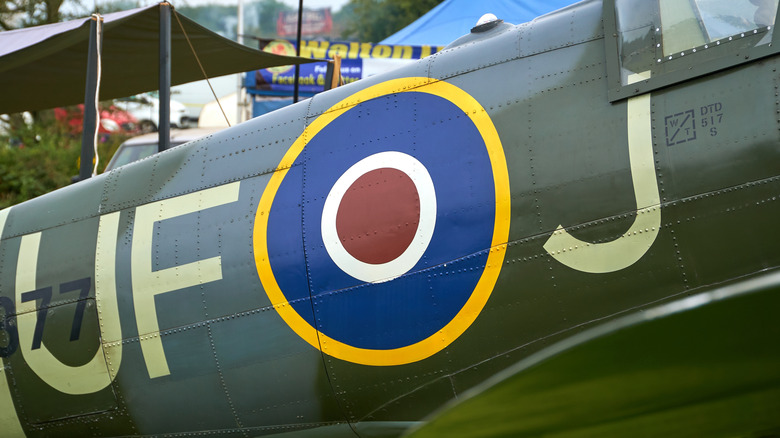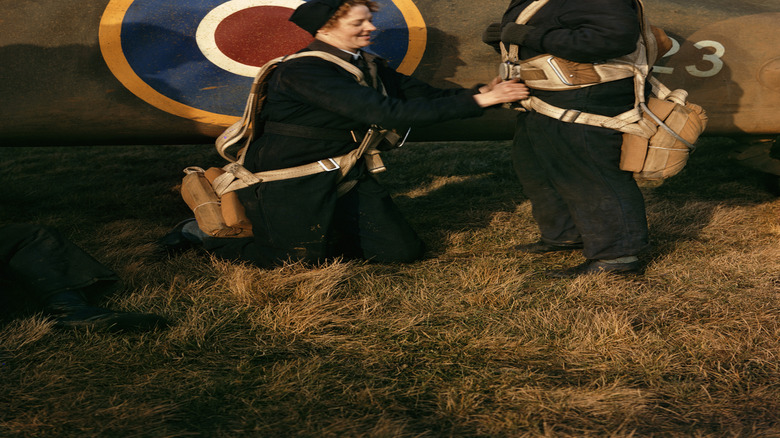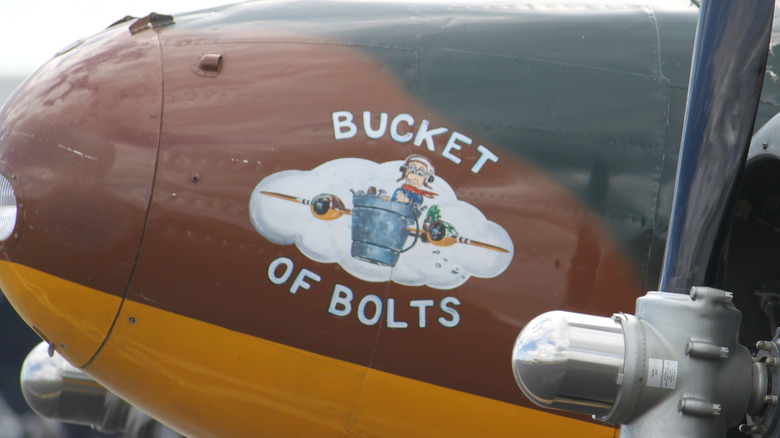What Were The Painted Targets On Old Warplanes For?
Even if you have only cursory knowledge of aviation and military history, odds are you can picture an old warplane in your mind. The drab colors, the massive propeller at the front, and the goggled pilots in the cockpit are images synonymous with the old days of military aviation. Their presence is all pretty self-explanatory, though some details aren't as easy to explain. For example, many images of these old school warplanes feature large targets, typically painted on their sides and wings. They don't serve a clear purpose at first glance, so why are they so common on these planes?
As it turns out, these massive, oftentimes multi-colored targets weren't put onto aircraft without reason. Due to the chaotic nature of aerial battle — known as dogfighting, which doesn't happen much anymore — it could be hard to distinguish aircraft from one another. More importantly, it could sometimes prove difficult to discern ally from enemy, so these symbols, referred to as roundels, were used to differentiate between the two. Such emblems would alert pilots whether a nearby aircraft was friendly or dangerous, so they could act accordingly. Their size and colors made them easy to identify quickly, as time was of the essence when locked in aerial combat.
While this seems like a helpful shorthand in combat situations, one can't help but feel putting a literal target out there was something of a danger. In truth, roundels didn't have much of an impact in the heat of battle.
Roundels weren't as much of a factor in battle as one might think
In any combat situation, be it in the air or on the ground, painting a target on oneself might seem like a bad idea. This, in theory, could lead the enemy to focus fire on a specific spot, heightening an already dangerous situation. In aerial combat, for example, these painted targets on wings and hulls seemed to make key areas stand out. Even though it's undeniable that these emblems made it easier for attackers to determine their enemies, that's pretty much where the danger began and ended. Even in the most intense dogfights in aerial combat history, they weren't much of a difference-maker.
In most cases, the roundels weren't that large compared to the rest of the aircraft, only taking up a small portion of its surface area. Therefore, in a high-speed, high-intensity situation, it wasn't of the utmost importance that one try to target them specifically. With other more vulnerable areas like the engine and cockpit available, trying to maneuver to hit the roundels was a comparative waste of effort. Not to mention, from an attacker's perspective, these were targets placed on the aircraft by the enemy; why should they be focused on to begin with?
Evidently, roundels were more of a signifier to help cut down on friendly fire than anything else. Meanwhile, other forms of aviation art carried a much deeper, more personal meaning to those in the cockpit.
Roundels were often accompanied by nose art
As notable and recognizable as roundels are, they're not the only identifying paint markers present on classic military planes. Throughout the Second World War, in particular, it wasn't uncommon to see fighter planes with pieces of art painted across the front. These personalized painted planes of World War II were adorned with what became known as nose art. As their name implies, they were often found at the front or "nose" of the plane, near the cockpit. Where roundels were intended for designating which side a plane was on, nose art took this labeling in a more personalized, morale-boosting direction.
The major purpose of nose art was self-expression. Painting a funny cartoon or a pinup model on the side of your plane made it truly feel like your own, and brought a bit of levity to an otherwise dire wartime situation. Seeing as the military brought with it a sense of uniformity, nose art was perfect for maintaining individuality while simultaneously reflecting the group sentiments of the troops. Additionally, it was a great way to keep spirits up, especially with younger recruits who wanted some form of outlet to rebel against the rigid and regimented nature of the military. Some even used it as a means of honoring wives, mothers, and families who awaited their safe return.
While the paint job of an aircraft might not seem notable, it has taken on a major level of importance throughout the decades. In their own ways, roundels and nose art alike serve as a reminder that there were real people in these aircraft, and that there was more to them than the aerial conflicts at hand.


